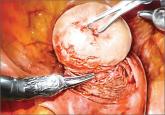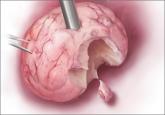Surgical Techniques

Tips and techniques for robot-assisted laparoscopic myomectomy
With robotic assistance, a surgeon can reduce blood loss, shorten hospitalization, and ease laparoscopic suturing and knot-tying—but myomectomy is...

Three intraoperative videos show surgical techniques from Javier F. Magrina, MD, and John B. Gebhart, MD, regarding morcellomas, and the vaginal approach to open hand morcellation with normal and large uterii
Read the related article: Benefits and pitfalls of open power morcellation of uterine fibroids by Robert L. Barbieri, MD (Editorial, February 2014)
SequElae of open power morcellation
by Javier F. Magrina, MD, and colleagues
Video courtesy of Javier F. Magrina, MD, Professor, Obstetrics-Gynecology, Mayo Clinic, Phoenix, Arizona; Immediate Past President, AAGL
Open morcellation of uterine fibroids may result in the dispersion of bits of tissue around the peritoneal cavity and surgical ports. If the fibroid contains genetic mutations that significantly increase the growth potential of fibroid cells, fibroid nodules may grow postoperatively in the pelvis, abdomen, and surgical ports. Investigators have called these disseminated nodules of fibroid tumor, “morcellomas.”
Vaginal approach to open hand morcellation using a colpotomy incision during hysterectomy
by Javier F. Magrina, MD, and colleagues
Video courtesy of Javier F. Magrina, MD, Professor, Obstetrics-Gynecology, Mayo Clinic, Phoenix, Arizona; Immediate Past President, AAGL
View Dr. Magrina and colleagues' technique for the vaginal approach to open hand morcellation of a normal-sized uterus with a colpotomy incision during hysterectomy.
Vaginal approach to open hand morcellation of a large uterus using a colpotomy incision during hysterectomy
by John B. Gebhart, MD, and colleagues
Video courtesy of John B. Gebhart, MD, Associate Professor and Fellowship Program Director, Mayo Clinic, Rochester, Minnesota
Watch Dr. Gebhart and colleagues' surgical technique for the vaginal approach to open hand morcellation of a large uterus with a colpotomy incision. It is critical to secure the uterine vessels before morcellation begins, and it is preferable to have entered both cul-de-sacs as well. Once those steps have been accomplished, bi-valve the cervix in the midline, following the endocervical canal to stay in the midline. Use a tenaculum to grasp bites of the uterus in an anterior and posterior fashion. This step reduces uterine size until the fundus can be inverted and the utero-ovarian pedicles secured.
WE WANT TO HEAR FROM YOU. Tell us what you think.

With robotic assistance, a surgeon can reduce blood loss, shorten hospitalization, and ease laparoscopic suturing and knot-tying—but myomectomy is...
The multiple advantages a laparoscopic approach to myomectomy can offer over laparotomy hinge on surgical technique—from preoperative evaluation...
New data and the guidance of our professional societies are bringing us closer to clarity in understanding the superiority of minimally invasive...
Challenges can be overcome by ensuring overall surgical expertise, adequate exposure, proper entry into the anterior cul-de-sac, good mobility,...

The current practice of open power morcellation is being scrutinized by those within and outside of the ObGyn community. We need to re-examine our...
